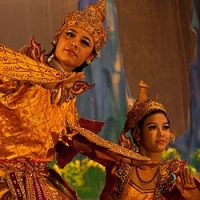Thida : The Iconic Heroine of the Burmese Ramayana
Listen
At a glance
| Description | |
|---|---|
| Origin | Burmese Mythology |
| Classification | Mortals |
| Family Members | Yama (Husband) |
| Region | Myanmar (Burma) |
| Associated With | Loyalty, Virtue |
Thida
Introduction
Thida is a central feminine figure in Burmese mythology, most widely recognised as the Burmese equivalent of Sita from the Indian epic Ramayana. In Myanmar, her story is preserved in the Yama Zatdaw, the national Burmese version of the epic, shaped by centuries of literary retellings, oral storytelling, and classical dance-drama traditions. While she retains the essence of Sita as the embodiment of loyalty, compassion, and purity, Thida also reflects uniquely Burmese cultural values influenced by Theravada Buddhism and indigenous cosmology.
The name Thida itself has deep cultural resonance in Myanmar. Commonly translated as “daughter,” “water,” or “daughter of the furrows,” it symbolises purity, fertility, and quiet strength. Within the Yama Zatdaw, Thida stands not only as a devoted wife but also as a model of moral resilience. Her trials—exile, separation, and steadfast virtue—mirror the spiritual ideals upheld in Myanmar’s cultural imagination. Through her, the Ramayana transforms into a distinctly Burmese story where devotion is paired with the Buddhist virtues of compassion, patience, and moral clarity.
Physical Traits
Classical Burmese depictions of Thida emphasise her grace rather than specific physical features. Traditional Yama Zatdaw performances present her as the ideal of feminine elegance, dressed in ornate royal attire associated with Burmese court culture. Her costumes feature flowing silk garments, golden ornaments, and delicate hairpieces that highlight her noble status. Burmese dance-drama also uses stylised movements—soft hand gestures, measured steps, and downcast eyes—to communicate her inner purity and emotional restraint.
Although Burmese mythology contains many supernatural beings with distinct physical attributes—such as Thayé spirits with exaggerated features—Thida is depicted entirely in human form. Her beauty is symbolic, conveying serenity, emotional depth, and devotion. The meaning of her name, associated with water and furrows, further aligns her with calmness, fertility, and moral cleanliness rather than dramatic physical traits.
Family
In the Burmese retelling of the Ramayana, Thida’s familial connections closely mirror those of Sita. She is the devoted wife of Yama, the Burmese version of Rama, whose righteousness and disciplined nature complement her own spiritual strength. Her bond with Lakhan (Lakshmana), her brother-in-law, is portrayed with deep respect, reflecting the moral and familial order central to the epic.
The narrative conflict arises when Thida is abducted by the demon king Dathagiri, the Burmese form of Ravana. This event becomes the emotional centre of the Yama Zatdaw, emphasising her resilience during captivity and reinforcing her role as an exemplar of steadfast loyalty. Although Burmese versions do not dwell extensively on her lineage before marriage, her importance is defined through her unwavering moral presence within Yama’s family and the larger ethical framework of the epic.
Other names
Thida appears under several spellings and related names depending on the language, region, and era. In Burmese script, variants such as Thidar or Thidaa occur in literature and inscriptions, reflecting transliteration differences. The name is directly associated with Sita, and in many Burmese manuscripts both names appear interchangeably.
Regionally parallel names in Southeast Asia showcase cultural adaptation. The Khmer form Teada/Teeda and the Thai form Theeda/Thida both carry meanings connected to “daughter,” “gift,” or “angel,” demonstrating a shared linguistic and mythological heritage across the region. In some modern interpretations, the name is also associated with concepts of brilliance, radiance, or even “star,” though these meanings are more symbolic than etymological.
The name’s popularity persists beyond mythology, widely used for Burmese girls today and strongly tied to notions of purity, affection, and familial love.
Powers and Abilities
Thida’s abilities are spiritual rather than physical, in keeping with the tone of Burmese adaptations of the Ramayana. She does not wield supernatural weapons or command elemental forces; instead, her power is rooted in inner purity and unwavering virtue. Throughout the Yama Zatdaw, she represents moral strength that influences events more deeply than overt magical abilities.
Her endurance in captivity, her refusal to compromise her principles, and her emotional resilience are portrayed as a form of sacred power. In some versions of the epic staged in Burmese theatre, symbolic elements such as lotus petals, soft light, or calm water accompany her presence, expressing her connection to purity and spiritual beauty.
Her greatest ability lies in her capacity to uphold dharma, inspire righteousness, and remain unshaken by suffering—a portrayal that aligns closely with Burmese Buddhist values emphasizing mental strength, ethical behaviour, and compassion.
Modern Day Influence
Thida remains an enduring presence in Myanmar’s cultural landscape. The Yama Zatdaw continues to be performed during festivals such as Thingyan, temple celebrations, and provincial cultural events, keeping her narrative alive for new generations. Her story appears in educational materials, temple murals, modern art, and televised performances, reinforcing her position as a timeless moral icon.
The name Thida is also popular in contemporary Myanmar beyond mythology. Notably, Ma Thida, the acclaimed writer, surgeon, and human rights advocate, has brought global attention to Myanmar’s sociopolitical struggles through her memoirs and activism. Her literary and humanitarian work has further elevated the cultural visibility of the name, associating it with courage, intellect, and moral determination.
In modern discussions about Southeast Asian folklore and cross-cultural storytelling, Thida’s character serves as a bridge connecting Indian epic traditions with uniquely Burmese artistic expression. Although ancient in origin, her symbolic value of loyalty, integrity, and emotional strength continues to resonate deeply in Myanmar’s evolving social and cultural identity.
Related Images
Source
Thida Cornes. About Me – Thida Cornes. https://www.thidacornes.com/about-me
Gavin Thomas Travel. (2016, March 9). A Burmese Bestiary – Gavin Thomas Travel – WordPress.com. https://gavinthomas.wordpress.com/2016/03/10/a-burmese-bestiary/
Wikipedia contributors. (2010, August 26). Thagyamin – Wikipedia. https://en.wikipedia.org/wiki/Thagyamin
Myanmar Online Tun Institute. (2008, September 30). Folk Elements in Burmese Buddhism. http://tuninst.net/MYANMAR/Folk-elements/ch01/ch01-folk-elem.htm
Wikipedia contributors. (2005, September 4). Buddhism in Myanmar. https://en.wikipedia.org/wiki/Buddhism_in_Myanmar
Wikipedia contributors. (n.d.). Yama Zatdaw. In Wikipedia. Retrieved November 27, 2025, from https://en.wikipedia.org/wiki/Yama_Zatdaw
Center for Southeast Asia and its Diasporas. (n.d.). The Ramayanas of Southeast Asia. University of Washington. https://jsis.washington.edu/csead/resources/educators/ramayanas-of-southeast-asia/
Bharat Ideology. (2024, January 19). Myanmar and Ramayana: An enduring epic’s legacy in the land of golden pagodas. https://bharatideology.com/myanmar-and-ramayana-an-enduring-epics-legacy-in-the-land-of-golden-pagodas/
Hla Pe. (1962). Burmese folklore. Rangoon University Press.
Spiro, M. E. (1967). Burmese supernaturalism. Transaction Publishers.
Jordt, I. (2007). Burma’s mass lay meditation movement: Buddhism and the cultural construction of power. Ohio University Press.
Aung-Thwin, M. (2011). Historiography of Burma: Narratives and myth-making. University of Hawai‘i Press.
Tin, M. (1973). Myth and ritual in Burmese culture. Myanmar Historical Society.
Frequently Asked Questions
Who is Thida in Burmese mythology?
Thida is the Burmese equivalent of Sita in the Yama Zatdaw, the Myanmar version of the Ramayana. She represents loyalty, purity, and resilience in Burmese cultural tradition.
What does the name Thida mean in Myanmar?
The name Thida commonly means “daughter,” and is also associated with purity, water, and beauty within Burmese cultural and linguistic traditions.
How is Thida depicted in the Yama Zatdaw?
Thida is portrayed as a graceful and virtuous woman, often shown in traditional royal attire. Her character reflects moral strength, devotion, and emotional endurance.
Does Thida have supernatural powers?
Thida’s abilities are symbolic rather than magical. Her spiritual purity, loyalty, and inner strength form her primary “powers” within the Burmese epic tradition.
How is Thida relevant in modern Myanmar?
Thida remains influential through Yama Zatdaw performances, cultural education, and popular use of her name. Figures like writer and activist Ma Thida also carry the name into contemporary significance.







